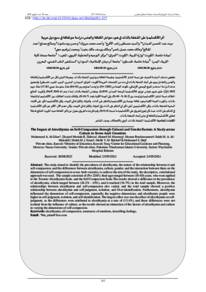Document
أثر الألكسثيميا على الشفقة بالذات في ضوء عوامل الثقافة والجنس : دراسة عبر ثقافات في سبع دول عربية.
Identifier
DOI: http://dx.doi.org/10.53543/jeps.vol18iss3pp261-277
Source
مجلة الدراسات التربوية والنفسية. مج. 18، ع. 3، ص. 261–277.
Contributors
الأقرع، السيد مصطفى راغب., Author
مرزوك، أحمد محمد. , Author
بودساموتو، حسن., Author
المقالح، صالح مصلح أحمد., Author
ناصر، مالك محمد جميل., Author
بخيت، مالك يوسف مالك., Author
حجيو، محمد إبراهيم., Author
Other titles
The impact of alexithymia on self-compassion through cultural and gender factors: A study across culture in seven Arab countries.
Country
عمان.
City
مسقط
Publisher
كلية التربية، جامعة السلطان قابوس.
Gregorian
2024-01-03
Language
العربية.
Subject
English abstract
The study aimed to identify the prevalence of alexithymia, the nature of the relationship between it and self-compassion, and the differences between alexithymia, culture, gender, and the interaction between them on the dimensions of self-compassion in seven Arab societies. To achieve the aim of the study, the descriptive, correlational approach was used. The sample consisted of (N = 2265); their ages ranged between (18–60) years, with a mean age of 27.28 years. The Toronto Alexithymia Scale (translated by Al-Edan, 2019a) and the Self-Compassion Scale developed by Neff (2003a) were applied. The results showed a difference in the prevalence of alexithymia, which ranged between (26.2%–49%), and it reached (36.7%) in the total sample. Moreover, the relationships between alexithymia and self-compassion also varied, and the total sample showed a positive relationship between alexithymia and self-judgment, isolation, and over-identification. Furthermore, alexithymia influenced the dimensions of self-compassion, especially the negative dimensions, and alexithymic people were higher in self-judgment, isolation, and over-identification. The largest effect size was the effect of alexithymia on self-judgment, as the differences were attributed to alexithymia at a rate of (13.4%), and these differences were not isolated from the influence of culture, as the results showed an interaction of the factors of alexithymia and culture in varying the dimensions of self-compassion.
ISSN
Online: 2521-7046
Print: 2218-6506
Arabic abstract
هدفت الدراسة للتعرف على نسبة انتشار الألكسثيميا، وطبيعة العلاقة بينها والشفقة بالذات، ومعرفة التباين لكل من الألكسثيميا والثقافة والجنس والتفاعل بينهم على أبعاد الشفقة بالذات في عدد من المجتمعات العربية (الكويت، العراق، السودان، البحرين، اليمن، المغرب، فلسطين). ولتحقيق هدف الدراسة استخدم المنهج الوصفي الارتباطي، تكونت العينة من (2265) فردًا، تراوحت أعمارهم بين (18–60) عامًا، بمتوسط عمري (27.28) عامًا، طبق عليهم مقياس تورنتو للألكسثيميا (ترجمة العيدان، 2019a)، ومقياس الشفقة بالذات إعداد نيف (Neff, 2003 a). وأظهرت النتائج اختلاف نسبة انتشار الألكسثيميا وتراوحت بين (26.2% - 49%)، وكذلك تباينت العلاقات بين الألكسثيميا والشفقة بالذات، وأظهرت العينة الكلية وجود علاقة موجبة بين الألكسثيميا والحكم على الذات، والعزلة، والإفراط في التوحد. وكان للألكسثيميا تأثير على أبعاد السلبية للشفقة بالذات، وكان الألكسثيميين أعلى في الحكم على الذات وفي العزلة، والإفراط في التوحد، وكان حجم الأثر الأكبر هو تأثير الألكسثيميا في الحكم على الذات حيث كان يُعزى للفروق على الألكسثيميا ما نسبته (13.4%)، ولم تكن هذه الفروق بمعزل عن تأثير الثقافة حيث أظهرت النتائج تفاعلاً لعاملي الألكسثيميا والثقافة في تباين أبعاد الشفقة بالذات.
Category
Journal articles

